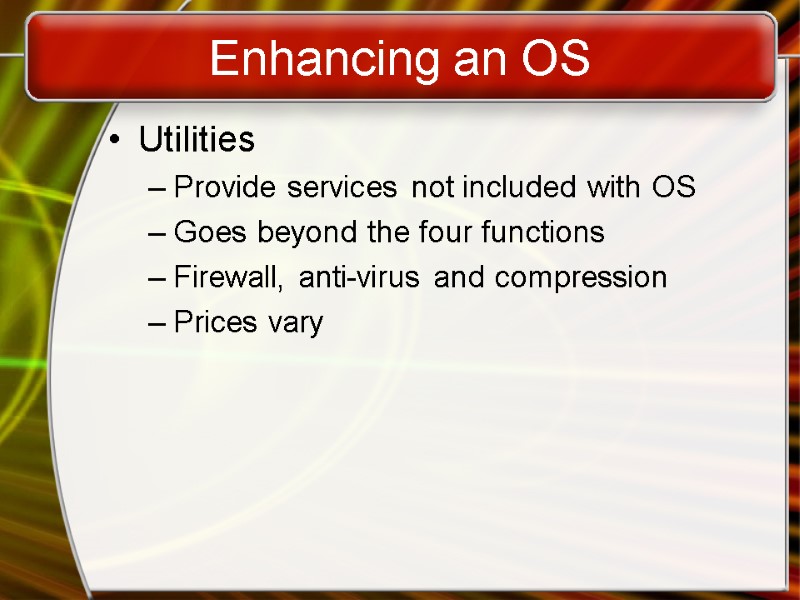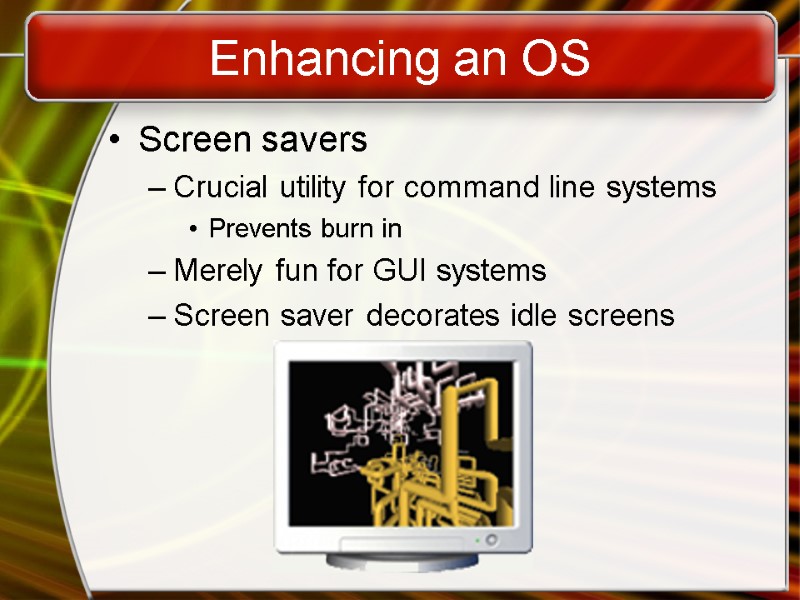Introduction to Computer Administration Operating System Basics Operating


Introduction to Computer Administration

Operating System Basics Operating System Operating System Objectives Layers of Computer Systems Services Provided by the Operating System Functions of Operating Systems Types of Operating Systems Enhancing an OS

Operating System A program that controls the execution of application programs An interface between applications and hardware

Operating System Objectives Convenience Makes the computer more convenient to use Efficiency Allows computer system resources to be used in an efficient manner Ability to evolve Permit effective development, testing, and introduction of new system functions without interfering with service

Layers of Computer System

Services Provided by the Operating System Program development Editors and debuggers Program execution Access to I/O devices Controlled access to files System access

Services Provided by the Operating System Error detection and response internal and external hardware errors memory error device failure software errors arithmetic overflow access forbidden memory locations operating system cannot grant request of application

Services Provided by the Operating System Accounting collect statistics monitor performance used to anticipate future enhancements used for billing users

Operating System Basics Ref Book: Chapter # 7: Introduction to Computers , Peter Norton McGraw-Hill. www.mhhe.com/peternorton

7A-10 Functions of Operating Systems Provide a user interface Run programs Manage hardware devices Organized file storage

Providing a User Interface User interface How a user interacts with a computer Require different skill sets

Providing a User Interface Graphical user interface (GUI) Most common interface Windows, OS X, Gnome, KDE Uses a mouse to control objects Uses a desktop metaphor Shortcuts open programs or documents Open documents have additional objects Task switching Dialog boxes allow directed input

Graphical User Interface

Providing a User Interface Command line interfaces Older interface DOS, Linux, UNIX User types commands at a prompt User must remember all commands Included in all GUIs

Command Line Interface

Running Programs Many different applications supported System call Provides consistent access to OS features Share information between programs Copy and paste Object Linking and Embedding

Managing Hardware Programs need to access hardware Interrupts CPU is stopped Hardware device is accessed Device drivers control the hardware

Organizing Files and Folders Organized storage Long file names Folders can be created and nested All storage devices work consistently

Types of Operating Systems Real-time operating system Very fast small OS Built into a device Respond quickly to user input MP3 players, Medical devices

Types of Operating Systems Single user/Single tasking OS One user works on the system Performs one task at a time MS-DOS and Palm OS Take up little space on disk Run on inexpensive computers

Single Tasking Operating System cannot be able to take control back from the running process/task/application In case if a process call an I/O Instruction then Processor must wait for I/O instruction to complete before preceding

Types of Operating Systems Single user/Multitasking OS User performs many tasks at once Most common form of OS Windows XP and OS X Require expensive computers Tend to be complex

Multitasking Operating System can take control back from the running process and can give it to other. When one job needs to wait for I/O, the processor can switch to the other job

Types of Operating Systems Multi user/Multitasking OS Many users connect to one computer Each user has a unique session UNIX, Linux, and VMS Maintenance can be easy Requires a powerful computer

Multi user/Multi tasking OS

Enhancing an OS Utilities Provide services not included with OS Goes beyond the four functions Firewall, anti-virus and compression Prices vary

Enhancing an OS Backup software Archives files onto removable media Ensures data integrity Most OS include a backup package Many third party packages exist

Backup Software

Enhancing an OS Anti-virus software Crucial utility Finds, blocks and removes viruses Must be updated regularly McAfee and Norton Anti-Virus

Enhancing an OS Firewall Crucial utility Protects your computer from intruders Makes computer invisible to hackers Zone Labs is a home firewall Cisco sells hardware firewalls

Enhancing an OS Intrusion detection Often part of a firewall package Announces attempts to breach security Snort is a Linux based package

Enhancing an OS Screen savers Crucial utility for command line systems Prevents burn in Merely fun for GUI systems Screen saver decorates idle screens

Reference Book: Introduction to Computers , Peter Norton McGraw-Hill. www.mhhe.com/peternorton
9938-4+-+operating+system+basics.ppt
- Количество слайдов: 33

